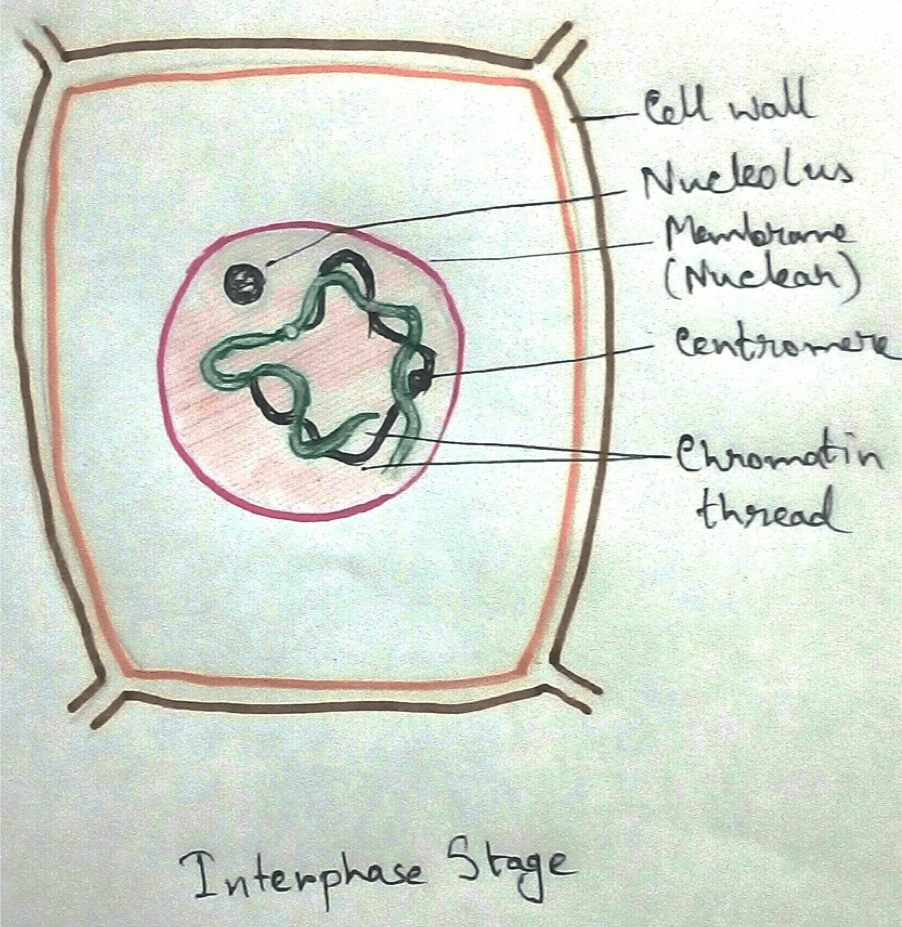Explain about Interphase
Definition of interphase- Interphase is a stage between two mitotic cycles in an eukaryotic cell, during which various physical and chemical changes for the preparation of cell division takes place.
Interphase of cell division is the longest period of cell division and is called inter-mitotic phase. The chromosomes appear as long and thin forms diffused chromatin net. It is not properly visible due to highly hydrated conditions.
Subdivisions of Interphase - In 1953 Howard and Pele divided interphase into 3 subtypes.
1. Post mitotic Gap phase - It is also called G1 phase. This phase occupies 30- 50% of the cell cycle .As it is the early stage of interphase and is called first growth phase. This phases are followed by –
* In this phase RNA and various regulatory proteins are synthesized.
* Enzymes those are required for DNA synthesis like DNA polymerase are synthesized.
* No DNA synthesis take place.
* Tubule is accumulated which causes elongation of the nucleus.
2. Synthetic phase (S-Phase) - It occupies 35 to 45% of the cell cycle. It is
called the mid interphase stage in which all the major metabolic activities of
dividing cell takes place.
The characteristics of stages are-
* DNA is synthesized in this phase.
* Volume of the nucleus becomes double when DNA is replicated.
* Here histone proteins are synthesized.
* Single chromatid of the chromosome gets duplicated to form two identical chromatids.
3. Pre-mitotic gap phase (G2 phase) - It constitutes 10 to 20% of cell cycle and also referred to as the second growth phase and actually is the gap between S phase and prophase .
Special characteristics of the interphase-
* Synthesis of specific RNA and protein.
* Stopping of DNA synthesis.
Major Characteristics of the Interphase
The major characteristics of interphase are:
1. The replication of chromatids and DNA .As a result the single chromatid (monad) becomes double (dyad).
2. Nuclear membrane remains intact and distinct.
3. Nucleolus enlarges due to accumulation of RNA and ribosomal protein in this stage.
4. Synthesis of energy rich ATP molecules and microtubules take place, that act as precursor of spindle fibres.
5. In general, the cells are increase in size due to accumulation of cytoplasm.
6. In case of animal cell , a new centrosome formed from the existing one with pair of centrioles which placed at right angles to each other. Means there are two pairs of centrioles in the cell.
7. In interphase the thin and elongated chromatin threads of the chromatin network appear diffused and less divisible due to highly hydrated conditions.
8. The net membrane biosynthesis increases and it remains stored at the cell surface in the form of blebs which help the cell to divide on animal cells.
Questions and Answers on Interphase:
1. What do you mean by G0 phase?
In terminally differentiated somatic cells like neurone and muscle cells which cannot be divided. This arrested phase of G1 is known as G0 phase.
2. When is interphase observed?
The period of interval which is observed between the two cell divisions is called interphase.
From Explain about Interphase to HOME PAGE
Recent Articles
-
What Is Plasma? | Blood Plasma | Proteins | Nutrients | Cholesterol
Nov 07, 25 10:29 AM
Blood is a mobile fluid which is a connective tissue and is derived from the mesoderm like cell any other connective tissue. Colour of blood is reddish and that flows inside the blood vessels by means… -
Disorders of Respiratory System | Tuberculosis | Pleurisy | Emphysema
Oct 28, 25 11:39 PM
Tuberculosis is very common disease and is caused by a type of bacteria called Mycobacterium tuberculosis. This disease causes different trouble in the respiration and infection of several parts of th… -
Regulation of Respiration | Respiratory Centres | Inspiratory Area |
Oct 14, 25 12:13 AM
Respiratory Centre is the area that controls the rate of respiration and it is observed to be located in medulla oblongata and pons. Respiratory Centre has the following will dispersed components like… -
Explain Transport of Gases | External Respiration | Tissue Respiration
Oct 09, 25 11:35 PM
In humans gaseous exchange is completed in the following ways the steps are - External Respiration or Breathing - Breathing in false taking in of Oxygen and giving out of carbon dioxide in the body. M… -
Kind and Number of Teeth | Location of Teeth in Mouth | Care of Teeth
Sep 11, 25 12:52 AM
Kind and Number of Teeth






New! Comments
Have your say about what you just read! Leave me a comment in the box below.